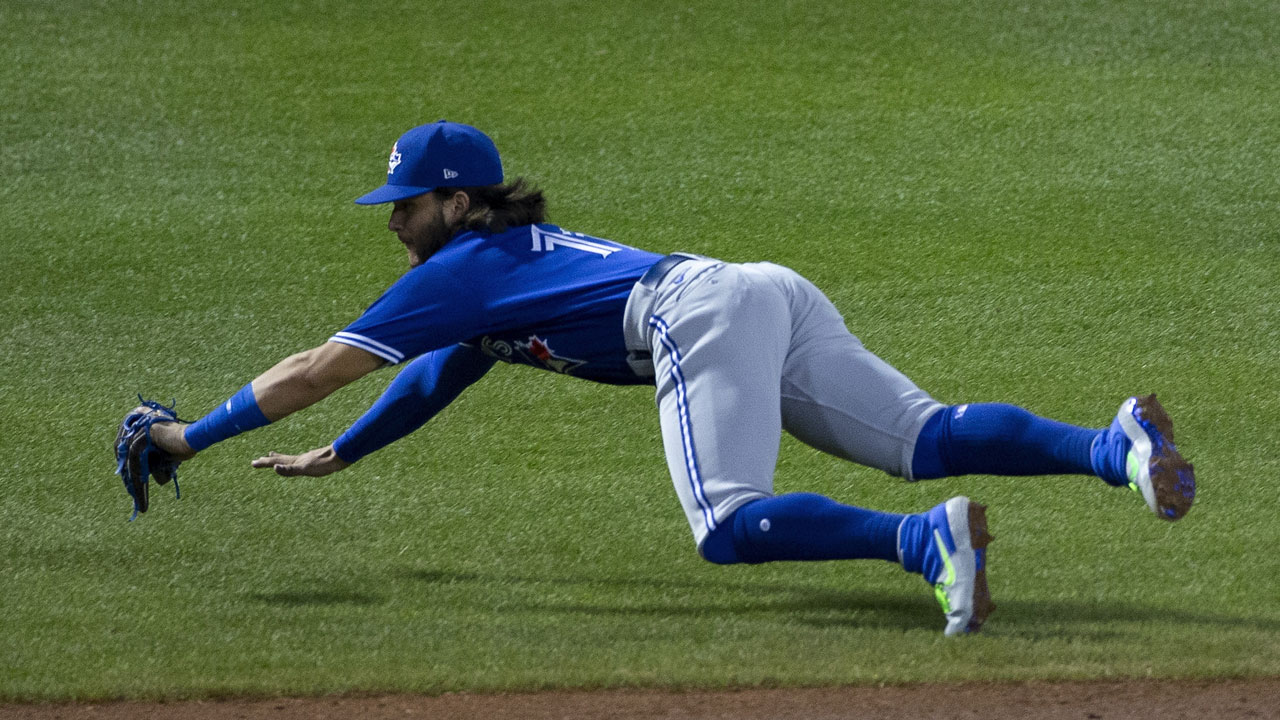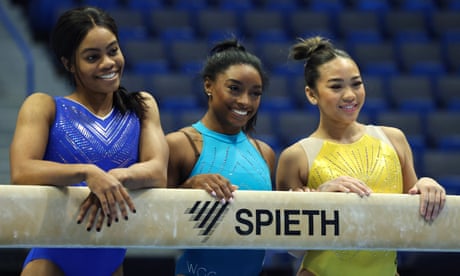
TORONTO – At the end of the 2018 season, the Toronto Blue Jays were wrestling with a pivotal question moving forward – is Bo Bichette really their shortstop of the future? The electric infielder had just completed a sensational season with the double-A New Hampshire Fisher-Cats, posting a .796 OPS in 595 plate appearances over 131 games, each one of them against a pitcher older than he was, in a league where he was 4½ years younger than the average player.
It was clear at that point he’d very soon be a big-leaguer, and an impactful one at that.
Still, the question that had followed him around since his high-school days in St. Petersburg, Fla., that continued after the Blue Jays stole him in the second round of the 2016 draft, that lingered as he sped up the minor-league ladder, remained as the moment of truth approached.
Was he actually a shortstop?
So, after the then 20-year-old helped the Fisher Cats win the Eastern League title, player development director Gil Kim put the question to the top prospect and Chris Barnard, the trainer Bichette had worked with since his senior year, during a meeting about next steps.
“The conversation was, ‘Hey, we want to know if he’s our actual shortstop,’” recalls Barnard. “And I remember, Bo being like, ‘I’m a shortstop. That’s what it is.’ So we went to work.”
Over the course of that off-season, Bichette worked relentlessly to improve his foundational base and his real-time decision-making so he could become a better defender. By the time he arrived at spring training last year, the conversations had completely flipped, and suddenly the team looked at him as someone who actually was going to be their shortstop of the future.
And now, when he takes the field as the Blue Jays’ everyday shortstop after experiencing his first opening day in the majors, the vision has become reality. Consider this play against the Boston Red Sox a few days ago.

“His range,” manager Charlie Montoyo says when asked what he likes most about Bichette’s range. “His range has been surprising. That play in Boston is as good as it gets, and that’s what I saw last year.”
Any last semblances of doubt about his readiness were removed after his recall last July 29, when he not only came out scorching hot at the plate, but looked more than capable in the field, too.
Within two weeks veteran stop-gap Freddy Galvis was put on waivers, and the position was his.
“We thought, ‘Oh, we’re going to miss Freddy,’” says Montoyo. “But when Bo came in, we didn’t miss Freddy, and that’s the best compliment I can give the kid.”
The roots of that confidence in Bichette trace back to the 2018-19 off-season, when Bichette remembers that the Blue Jays, “felt like, ‘OK, we need to know if Bo is our shortstop or not.’”
At that point, Aledmys Diaz was about to be traded to the Houston Astros and Lourdes Gurriel Jr., was still a shortstop, although there were even more questions about his glove than that of Bichette.
Once he heard that Blue Jays weren’t sure about him, “well, I wanted to improve everything,” he says. “I wanted more range, I wanted more quickness, I wanted more control of my body. So we worked on my speed, worked on my side-to-side, change of direction. The difference was huge. When I showed up the next spring, everybody knew I did something, and definitely I could see it, too, just because of the plays I was making.”
Kim recalls the fateful conversation a bit differently, without Bichette’s future at the position being put in such stark terms. He isn’t surprised, though, at how the now 22-year-old viewed the discussion.
“Bo takes everything as a challenge,” says Kim. “It’s what makes him so good.”
Still, Bichette’s training patterns have long intrigued the Blue Jays, from the creative hitting work he’d do with his former all-star dad Dante, who was hired as a major-league coach during summer camp, to the workouts he does with Barnard.
The Blue Jays even dispatched high-performance staff to see what Barnard was up to in the St. Petersburg, Fla., facility where Dante walked in with Bichette and older brother Dante Jr., four years ago.
At the time, Bichette was an on-the-rise draft prospect but his training regimen was designed by Dante. While he wanted to lift weights and get stronger, “I didn’t want to do it with my dad,” he says.
Barnard was initially skeptical when the family arrived, even fluffing off the kids to an assistant, although he kept a watchful eye on their first session in the gym.
“He saw the way we jump and the way we run, and he was like, ‘OK, they might actually be pretty good athletes,’” recalls Bichette. “I think most dads come in and they kind of BS around the situation and act like the kid is really good. And he wasn’t having that. So when he saw us actually start to move, he was like, ‘OK, they have some potential.’ The next time I came in, it was him training us.”
Says Barnard: “Dante was super humble, he didn’t mention who he was. He didn’t mention who his boys were. He just said, ‘My boys are pretty good ballplayers.’ At the time I was building other sides of the business but I was still training athletes, I had a draft prep guy. But I had a lot of high school dads coming, ‘Can you train my son, he’s going to be the next all-world.’ And it wasn’t that I don’t give them time. It’s just when I commit to a player, I want to see it through for the rest of their career. I’m all in with that person. So that next time, I was like, ‘OK, let’s take it somewhere.’”
Their initial focus was on improving Bichette’s foot-speed, and Barnard essentially rebuilt his stride like that of a track athlete. Through cleaner running mechanics alone – “it’s all physics,” says the trainer – Bichette’s running improved dramatically, with work in subsequent years, helping him steal 22 bases in his first full season of pro ball and 32 at double-A in 2018.
The following off-season they targeted his defence. Barnard broke down film of top shortstops and designed a variety of drills that would create both the physical capacity and muscle-memory needed to pull off a variety of plays.
“We did these things where I was shuffling back and forth between a cone, he’d throw me balls in the air, I’d have to change direction to get it,” says Bichette. “He’d do it on the ground where I had to get it. We’d use those spark balls with the points on the end and I would just basically do a full sprint, he’d roll it at me, and I’d have to go whichever way the ball went.”
The goal, initially, was to build up an ability to quickly change direction laterally, in different ranges.
“Later, it was addressing true agility,” says Barnard, “which is actually just adding a reactionary component. Any form of tennis ball drill, having him react off multiple ones, just creating a higher stimulus than what he’s going to see on the field. By doing that, it got him really used to trying to react off multiple different things and processing so much information while moving in those ranges of motion.”
The benefits can be seen on a play like the one Bichette made in Boston. From this close-up angle, you can see the way he stops his momentum after laying out and then creates force in the opposite direction on the throw.

“To me, it’s really about being athletic,” he says. “Everything can’t be perfect. If you’re trying to be perfect to make a play, it’s not always going to go well. You have to be able to do things that are out of comfort.”
This past off-season, the focus was on building strength, as they were relatively satisfied with where things stood in terms of speed and agility. Bichette feels it was his best winter in terms of weight-lifting, and during the pandemic shutdown, they used a similar regimen, and included infielder Santiago Espinal and outfielder Forrest Wall, who both sheltered at the Bichette home.
“Bo really committed a lot to his outside-the-gym activities, too,” says Barnard. “That’s recovery and nutrition, and his commitment really paid off dividends. When he was coming back to every training session, he was on. It’s a testament to him wanting to be great at every single aspect, to be a five-tool guy. This year, really what we were trying to accomplish was, let’s get a little bit more leaned out, what I like to call efficient. If you’re lugging around a couple extra pounds of body fat, it’s really not serving you on the field. He approached it really well and he’s got a lighter bodyweight. He’s got more power and more strength than I’ve seen in him. And he hasn’t even really come into what I like to call his man-strength yet.
“It’s just exciting to watch him continue.”
All the more so for the Blue Jays, who finally a shortstop of the present who is also a shortstop of the future, too.







